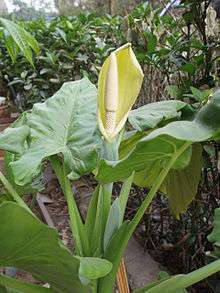Alocasia macrorrhizos
| Alocasia macrorrhizos | |
|---|---|
 | |
| Scientific classification | |
| Kingdom: | Plantae |
| (unranked): | Angiosperms |
| (unranked): | Monocots |
| Order: | Alismatales |
| Family: | Araceae |
| Genus: | Alocasia |
| Species: | A. macrorrhizos |
| Binomial name | |
| Alocasia macrorrhizos (L.) G.Don[1] | |
| Synonyms[1] | |
| |
Alocasia macrorrhizos is a species of flowering plant in the arum family, Araceae, that it is native to rainforests from Malaysia to Queensland[1] and has long been cultivated on many Pacific islands and elsewhere in the tropics. Common names include giant taro,[2] ʻape, giant alocasia and pai.[3] In Australia it is known as the cunjevoi[3] (although that term also refers to a marine animal).
It is edible if cooked for a long time but its sap irritates the skin due to calcium oxalate crystals, or raphides which are needle like.[4] Alocasia species are commonly found in marketplaces in Samoa and Tonga and other parts of Polynesia. The varieties recognized in Tahiti are the Ape oa, haparu, maota, and uahea. The giant heart-shaped leaves make impromptu umbrellas in tropical downpours.
The Hawaiian saying: ʻAi no i ka ʻape he maneʻo no ka nuku (The eater of ʻape will have an itchy mouth) means "there will be consequences for partaking of something bad".[5]
In a 2012 study, it was found out that the domesticated giant taro originated from the Philippines.[6]
References
- 1 2 3 "Alocasia macrorrhizos". World Checklist of Selected Plant Families. Royal Botanic Gardens, Kew. Retrieved 2016-09-30.
- ↑ "Alocasia macrorrhizos". Natural Resources Conservation Service PLANTS Database. USDA. Retrieved 2016-09-30.
- 1 2 "Alocasia macrorrhizos (L.) G. Don". Germplasm Resources Information Network. United States Department of Agriculture. 2006-11-06. Retrieved 2010-05-23.
- ↑ Susan Scott; Craig Thomas (2009). Poisonous Plants of Paradise: First Aid and Medical Treatment of Injuries from Hawaii's Plants. University of Hawaii Press.
- ↑ Pukui, Mary Kawena (1986). ‘Ōlelo No'eau, Hawaiian Proverbs and Sayings. Honolulu: Bishop Museum Press.
- ↑ Nauheimer, L; Boyce, P.C.; Renner, S.S. (2012). "Giant taro and its relatives: A phylogeny of the large genus Alocasia (Araceae) sheds light on Miocene floristic exchange in the Malesian region". Molecular Phylogenetics and Evolution. 63 (1): 43–51. doi:10.1016/j.ympev.2011.12.011. PMID 22209857.
External links

![]() Media related to Alocasia macrorrhizos at Wikimedia Commons
Media related to Alocasia macrorrhizos at Wikimedia Commons
![]() Data related to Alocasia macrorrhizos at Wikispecies
Data related to Alocasia macrorrhizos at Wikispecies
- More Information On Alocasia Macrorrhiza
- Alocasia Macrorrhiza Growing Tips
- http://www.canoeplants.com/ape.html